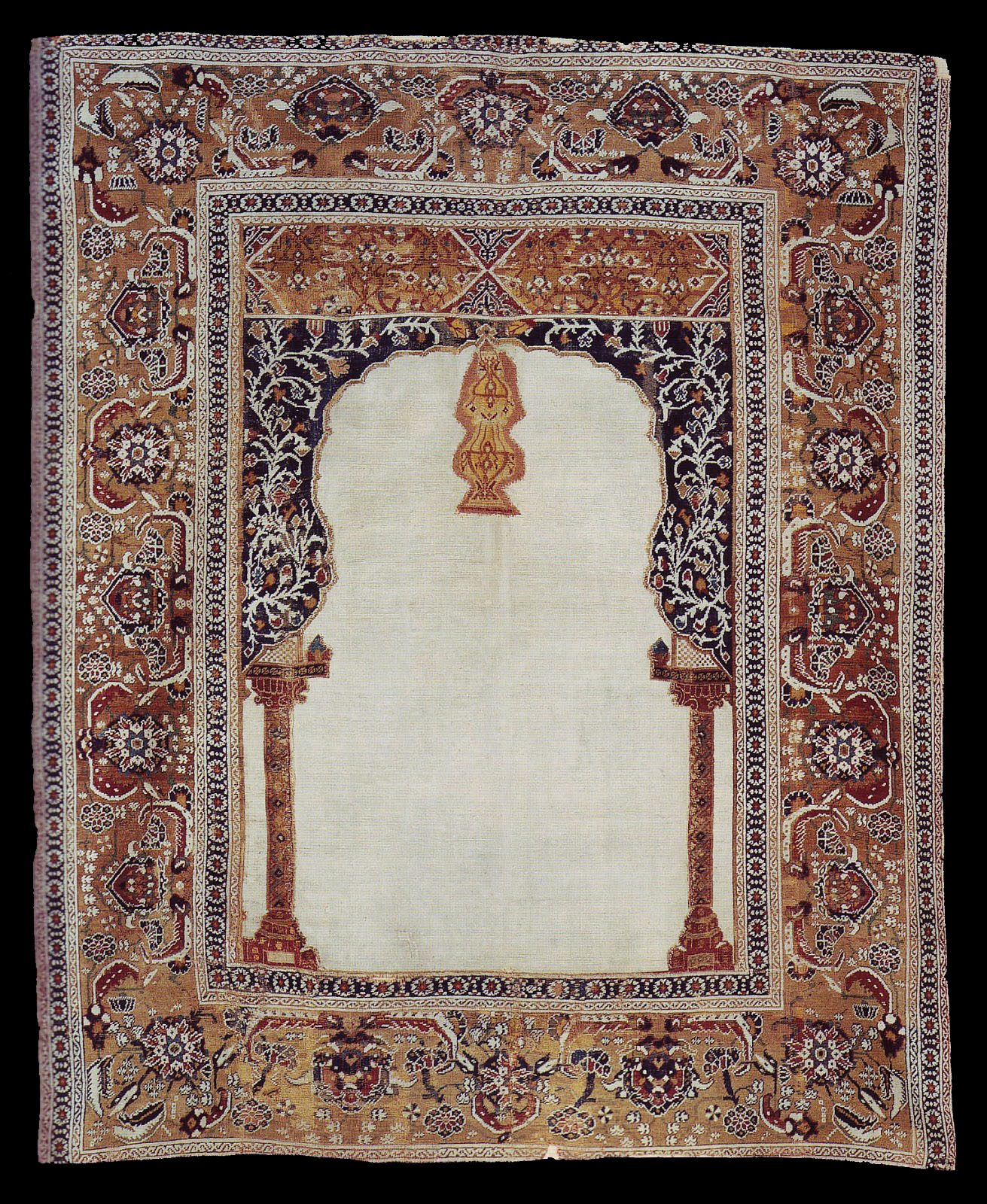|
Cairene Ottoman prayer rug, 17th century. Formerly, Davide
Halevim & Wher Collection (Hali4-1,page 56)
AN OTTOMAN COURT PRAYER RUG
ISTANBUL OR POSSIBLY CAIRO, LATE 16TH CENTURY
The ivory cotton field with a pendant mosque-lamp beneath a shaded
indigo arch containing ivory flowering vine supported by columns on
either side, a linked floral double cartouche cross-panel above, in a
pale beige border of palmettes flanked by serrated leaves and
flowering vine alternating with rosettes between linked S-motif and
rosette stripes, slight loss at each end, rewoven pendant, scattered
touches of repiling
4ft.11in. x 4ft.1in. (149cm. x 124cm.)
Price Realized £91,750 ($133,313)
Sale Information
Christies SALE 6423
DAVIDE HALEVIM :
MAGNIFICENT CARPETS & TAPESTRIES
14 February 2001
London, King
Street
Lot Notes
The present rug is one of a group of
just fifteen complete or partial rugs with silk foundations which are
known to have survived to the present day. A complete list of these is
given by Daniel Walker in his discussion of the example in the
Cleveland Museum (Denny, Walter B. and Walker, Daniel (intro. by): The
Markarian Album, Cincinatti, 1988, pp.54-60, esp. note 2, p.60). Of
the fifteen, eight share the design of the present rug with its plain
field, one of the best of which is that formerly at Amberly Castle and
now in the al-Sabah Collection, Kuwait (Herrmann, Eberhart: Seltene
Orientteppiche IV, Munich, 1982, no.1, pp.57-9).
In his
discussion of the group detailed above, Daniel Walker notes that four
rugs, of which the present example is one, form a subgroup all with
the same design but with slightly less curvilinear drawing and
slightly lower knot count. The other three in this subgroup are those
in the Khalili Collection (Rogers, J.M.: Empire of the Sultans,
Ottoman Art from the Collection of Nasser D. Khalili, Geneva, 1995,
no.135, pp.200-202), one offered in these Rooms 19 April 1979, lot 22,
and one which appeared many years ago in the sale of the collection of
V. Everit Macy (American Art Association, New York, 7 January 1938,
lot 331). Most of the rugs in the larger group make extensive use of
cotton. The border ground colour of a number is light blue cotton.
White cotton in large quantities is rarer; the al-Sabah rug has white
cotton spandrels, as do the Walters Art Gallery and Ballard Collection
rugs (Ettinghausen, R. et al.: Prayer Rugs, exhibition catalogue,
Textile Museum, Washington D.C., 1974, nos. 2 and 1) together with the
fragmentary example in Budapest (Vegh, Gyula and Layer, Károly:
Turkish Rugs in Transylvania, Fishguard, 1977, no.20). None however
apart from the present example try using cotton for the main mihrab
panel.
This group of rugs with silk warps has traditionally
been attributed to Bursa. Daniel Walker points out the challenge to
this set by the discovery of the Medici Cairene rug which can be dated
to before 1623, the year in which it entered the Medici Collection. It
has the light blue border and extensive cotton details noted in the
silk warped group, but is said in the inventory record to come from
Cairo. The products of the Imperial workshop in Istanbul have not been
idenitfied with any certainty and it is still tempting to attribute
this group to that atelier. The claim of Bursa is weakened by the fact
that the last textual record of carpet weaving at Bursa dates from
1525, while records of weavers continue through the century and beyond
in both Istanbul and Cairo (Pinner, Robert: "Appendix [of textual
sources]" Oriental Carpet and Textile Studies II Carpets of the
Mediteranean Countries 1400-1600, London, 1986, pp.291-294).

picture courtesy: John Taylor,
rugtracker.com
|

